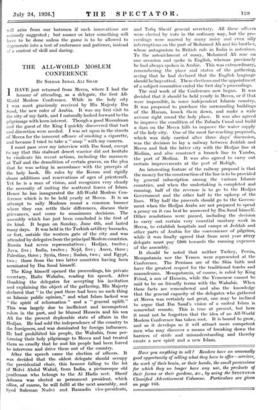A FOURTH STUMP IN CRICKET
THE drawn Test Matches have converted Lord Harris to the view that the rules of cricket need 'revision ! We live in a revolutionary epoch. Constitu- tions and dynasties; we imagined, might come and go, but the rules of cricket—these at any rate we had sup- posed were fixed and immutable. The shock of Lord Harris' pronouncement has been considerable. That a thing so superbly English as cricket should be changed 'seems almost impossible ; yet, before we too hastily eonaemn the innovators, we must consider whether they have not a case. It may be that they can even claim to be more conservative than we arc ourselves.
Can it be that considerations of this sort have influ- enced Lord Harris ? The rules of cricket have indeed remained almost constant for several decades, but mean- while the game itself has been steadily changing. By slow but inexorable stages the bat has gained greater and greater mastery over the ball. Whether this is due to a lack of tireless fast bowlers, to modern scientifically dressed wickets, or to an enormous growth in batting skill we do not pretend to say. But the fact remains that average scores have risen steadily and continuously for the last ten years. In the Gentlemen and Players match last week over 1,100 runs were scored in their two first innings, and perhaps the climax was reached in the last Test, when England, after having made just under three hundred runs, was generally described as having " collapsed " ! What would Grace have said of such a situation as that ? There is a strong case, then, for the view that some change in the rules would be not so much an innovation in the game as an attempt to restore it to its old position. The old equilibrium between bat and ball would be re-established.
Three days would be again sufficient time to play out the most important match. Until now the M.C.C. has set its face consistently against the attempts of the Press to extend the time of the Test Matches beyond that limit. Three days are long enough for most of us for any game in our crowded modern world. But equally, of course, the farce of first-class matches in which there is only the faintest hope of a finish must be ended if the game is to survive. Therefore the M.C.C., as the unquestioned legislator for the game, is being driven into the difficult position which has been so frankly avowed by Lord Harris. If the four days match is rejected, we come to the great question of how, if at all, the rules arc to be modified. There are, it seems to us, three main possibilities :—First the modern artificial wicket might be prohibited. In many ways this would be the most satisfactory thing to do. It would leave the actual practices of the game untouched, and it would achieve the object arrived at, i.e., the restoration of the game to its old condition, by abolishing the new factor which, in the opinion of most people, is the disturbing element. But there is one great difficulty. How could any standard be established as to how good a pitch should be allowed to be ? This seems an almost fatal objection.
The second measure would be an alteration in the present L.B.W. rule. At present, of course, the batsman is not out if his legs are struck by a ball which by reason of its break would bowl him, although it pitched off the wicket. If the L.B.W. rule were changed, and simplified, so that the batsman is out if his legs obstruct any ball which would in fact have bowled him,. however it may have pitched, the bowler would be perceptibly aided. This would be a simple and non-revolutionary change to make. But it is doubtful whether when batsmen had become accustomed to the new conditions it would do enough to shorten the game. It would also present obvious difficulties to umpires. The third possibility is an alteration in the size of the wicket. A fourth stump might be added or the height of the existing three stumps might be increased. The first -alternative would be in line with cricket traditions, for the third stump itself is, of course, an innovation, comparatively speaking. We do not pretend to be learned enough in the history of the game to know whether the third stump was added in a. difficulty com- parable to the present one. Was it that beirhiskered and top-hatted batsmen could not be defeated when they had only two stumps to defend ? (Perhaps sonic reader will enlighten us on this point ?) A change in the size of the wicket would, of course, be a most daring and radical. innovation, but we may yet be forced to it. Would it not at any rate be worth while to play an experimental match with first class players with a fourth stump ? The effect on the game would at any rate be extraordinarily interesting. What a premium it would set on quickness of foot in our batsmen ! Think of the effort of "getting over" to that infinitely moil distant off-stump ! Or, on the other hand, if you had chosen " middle " (" middle" of the wicket not "middle stump" of four) as your guard, you might make the most care-free hit at what you thought was a half volley to leg, only to find that it had taken your .outside leg stump ! We can imagine the howl of dismay whiell will arise from our batsmen if such innovations are seriously suggested ; but sooner or later something will have to be done unless the game is to be allowed to degenerate into a test of endurance and patience, instead of a contest of skill and daring.



















































 Previous page
Previous page